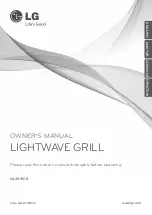
4 ENGLISH
SAFETY WARNINGS
General power tool safety warnings
WARNING:
Read all safety warnings, instruc-
tions, illustrations and specifications provided with this
power tool.
Failure to follow all instructions listed below
may result in electric shock, fire and/or serious injury.
Save all warnings and instruc-
tions for future reference.
The term "power tool" in the warnings refers to your mains-oper-
ated (corded) power tool or battery-operated (cordless) power tool.
Hammer drill safety warnings
Safety instructions for all operations
1.
Wear ear protectors when impact drilling.
Exposure to noise can cause hearing loss.
2.
Use the auxiliary handle(s).
Loss of control can
cause personal injury.
3.
Hold the power tool by insulated gripping surfaces, when
performing an operation where the cutting accessory may
contact hidden wiring or its own cord.
Cutting accessory
contacting a "live" wire may make exposed metal parts of the
power tool "live" and could give the operator an electric shock.
4.
Always be sure you have a firm footing. Be sure no
one is below when using the tool in high locations.
5.
Hold the tool firmly with both hands.
6.
Keep hands away from rotating parts.
7.
Do not leave the tool running. Operate the tool
only when hand-held.
8.
Do not touch the drill bit or the workpiece
immediately after operation; they may be
extremely hot and could burn your skin.
9.
Some material contains chemicals which may be
toxic. Take caution to prevent dust inhalation and
skin contact. Follow material supplier safety data.
10.
If the drill bit cannot be loosened even you open the
jaws, use pliers to pull it out.
In such a case, pulling out
the drill bit by hand may result in injury by its sharp edge.
Safety instructions when using long drill bits
1.
Never operate at higher speed than the maximum
speed rating of the drill bit.
At higher speeds, the
bit is likely to bend if allowed to rotate freely without
contacting the workpiece, resulting in personal injury.
2.
Always start drilling at low speed and with the bit
tip in contact with the workpiece.
At higher speeds,
the bit is likely to bend if allowed to rotate freely without
contacting the workpiece, resulting in personal injury.
3.
Apply pressure only in direct line with the bit and do
not apply excessive pressure.
Bits can bend causing
breakage or loss of control, resulting in personal injury.
SAVE THESE INSTRUCTIONS.
WARNING:
DO NOT let comfort or familiarity with
product (gained from repeated use) replace strict adher-
ence to safety rules for the subject product. MISUSE or
failure to follow the safety rules stated in this instruc-
tion manual may cause serious personal injury.
FUNCTIONAL
DESCRIPTION
CAUTION:
Always be sure that the tool is
switched off and unplugged before adjusting or
checking function on the tool.
Switch action
WARNING:
Before plugging in the tool,
always check to see that the switch trigger actu
-
ates properly and returns to the "OFF" position
when released.
►
Fig.1:
1.
Switch trigger
2.
Lock button
To start the tool, simply pull the switch trigger. Tool
speed is increased by increasing pressure on the switch
trigger. Release the switch trigger to stop.
For continuous operation, pull the switch trigger, push
in the lock button and then release the switch trigger.
To stop the tool from the locked position, pull the switch
trigger fully, then release it.
CAUTION:
Switch can be locked in “ON” posi
-
tion for ease of operator comfort during extended
use. Apply caution when locking tool in “ON”
position and maintain firm grasp on tool.
Reversing switch action
CAUTION:
Always check the direction of
rotation before operation.
CAUTION:
Use the reversing switch only after
the tool comes to a complete stop.
Changing the
direction of rotation before the tool stops may dam
-
age the tool.
►
Fig.2:
1.
Reversing switch lever
This tool has a reversing switch to change the direc-
tion of rotation. Move the reversing switch lever to the
position (A side) for clockwise rotation or to the posi-
tion (B side) for counterclockwise rotation.
Selecting the action mode
CAUTION:
Always slide the action mode
changing lever all the way to your desired mode
position.
If you operate the tool with the lever posi-
tioned halfway between the mode symbols, the tool
may be damaged.
►
Fig.3:
1.
Action mode changing lever
This tool has an action mode changing lever. For rota-
tion with hammering, slide the action mode changing
lever to the right (
symbol). For rotation only, slide the
action mode changing lever to the left (
symbol).





































